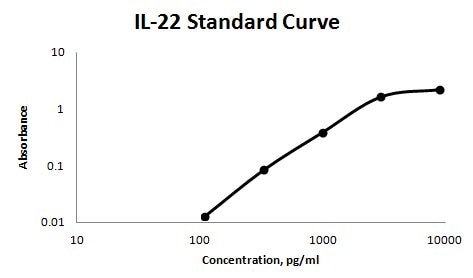Human Resistin Biotinylated Antibody Summary
Accession # Q9HD89
Applications
under non-reducing conditions only
Human Resistin Sandwich Immunoassay
Please Note: Optimal dilutions should be determined by each laboratory for each application. General Protocols are available in the Technical Information section on our website.
Reconstitution Calculator
Preparation and Storage
- 12 months from date of receipt, -20 to -70 °C as supplied.
- 1 month, 2 to 8 °C under sterile conditions after reconstitution.
- 6 months, -20 to -70 °C under sterile conditions after reconstitution.
Background: Resistin
Resistin (resistance-to-insulin), also known as adipocyte-specific secretory factor (ADSF) and found in inflammatory zone 3 (FIZZ3), is a 10 kDa member of a small family of secreted cysteine-rich peptide hormones. These molecules purportedly play some role in inflammation, glucose metabolism, and angiogenesis (1-4). Human Resistin precursor is 108 amino acids (aa) in length. It contains an 18 aa signal sequence plus a 90 aa mature region. The mature region shows an N-terminal alpha -helical tail (aa 23-44) and a C-terminal beta -sheet globular head (aa 47-108) (5-7). The Resistin molecule circulates as either a noncovalent trimer (minor form), or a disulfide-linked homohexamer (major form). Noncovalent trimers are generated when the alpha -helical segments self-associate to form a three-stranded coiled-coil structure. Covalent hexamers subsequently appear when the free Cys at position #26 is engaged by adjacent trimers. It is hypothesized that the hexamer is the inactive form of the molecule, and bioactivity is achieved at the target site by disulfide bond reduction (5). Although Resistin family molecules can noncovalently interact to form heterotrimers in vitro, there is no evidence to suggest this occurs in vivo with Resistin (8, 9). Mature human Resistin shares 56% and 54% aa identity with mouse and rat Resistin, respectively. Rat Resistin possesses an alternate start site at Met48; this Met is not found in the mouse molecule, however (10). Rodent resistin is expressed by white adipocytes, splenocytes, astrocytes, and anterior pituitary epithelium (6, 11, 12). Although the function of Resistin is unclear, it would seem to block insulin-stimulated uptake of glucose by adipocytes and promote glucose release by hepatocytes (6, 13, 14). As such, it has been proposed to participate in diet-induced insulin-sensitivity. Diets high in fat promote an increase in overall adipocyte size. Hypertrophic adipocytes are known to secrete TNF-alpha which acts locally to block ACRP30 production. Since ACRP30 is an insulin-sensitizer, a drop in ACRP30 availability leads to insulin-insensitivity, which drives increased insulin production (a compensatory mechanism). High insulin induces Resistin secretion which now antagonizes insulin action, prompting more insulin production and more Resistin secretion (15).
- Kottke, M.D. et al. (2006) J. Cell Sci. 119:797.
- Garrod, D.R. et al. (2002) Mol. Membrane Biol. 19:81.
- Leckband, D. and A. Prakasam (2006) Annu. Rev. Biomed. Eng. 8:259.
- King, I.A. et al. (1993) Genomics 18:185.
- Theis, D.G. et al. (1993) Int. J. Dev. Biol. 37:101.
- King, I.A. et al. (1996) J. Invest. Dermatol. 107:531.
- Nuber, U.A. et al. (1996) Eur. J. Cell Biol. 71:1.
- Chidgey, M. et al. (2001) J. Cell Biol. 155:821.
- Khan, K. et al. (2006) Br. J. Cancer 95:1367.
- Hashimoto, T. et al. (1997) J. Invest. Dermatol. 109:127.
- Caubet, C. et al. (2004) J. Invest. Dermatol. 122:1235.
- Descargues, P. et al. (2006) J. Invest. Dermatol. 126:1622.
Product Datasheets
Citations for Human Resistin Biotinylated Antibody
R&D Systems personnel manually curate a database that contains references using R&D Systems products. The data collected includes not only links to publications in PubMed, but also provides information about sample types, species, and experimental conditions.
2
Citations: Showing 1 - 2
Filter your results:
Filter by:
-
Low Plasma IL-8 Levels During Chemotherapy Are Predictive of Excellent Long-Term Survival in Metastatic Breast Cancer
Authors: L Tiainen, M Hämäläinen, T Luukkaala, M Tanner, O Lahdenperä, P Vihinen, A Jukkola, P Karihtala, E Moilanen, PL Kellokumpu
Clin. Breast Cancer, 2019-04-04;0(0):.
Species: Human
Sample Types: Plasma
Applications: ELISA Detection -
A novel ultra-sensitive enzyme immunoassay for soluble human insulin receptor ectodomain and its measurement in urine from healthy subjects and patients with diabetes mellitus.
Authors: Umehara A, Nishioka M, Obata T
Clin. Biochem., 2009-06-25;42(13):1468-75.
Species: Human
Sample Types: Serum
Applications: ELISA Development
FAQs
No product specific FAQs exist for this product, however you may
View all Antibody FAQsReviews for Human Resistin Biotinylated Antibody
Average Rating: 5 (Based on 1 Review)
Have you used Human Resistin Biotinylated Antibody?
Submit a review and receive an Amazon gift card.
$25/€18/£15/$25CAN/¥75 Yuan/¥2500 Yen for a review with an image
$10/€7/£6/$10 CAD/¥70 Yuan/¥1110 Yen for a review without an image
Filter by:
MAB7821 was used as the solid phase antibody, BAM1359 was used as the detection antibody. 1259-RN was used as the immunoassay standard. Sensitivity of the assay was around 100 pg/ml.


